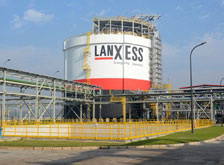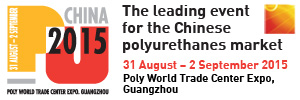
German speciality chemicals company Lanxess says it has successfully started its new EPDM plant in Changzhou (Jiangsu Province), China, with a capacity of 160,000 tonnes/year. With the gradual ramp-up of the new plant, the company says it has completed its global EPDM (ethylene propylene diene rubber) asset base.
Over the next months Lanxess will be running sampling and approbation processes with customers. The new plant will produce in total ten premium grades of EPDM tailored to Chinese and Asian customer needs.
When Lanxess announced the new plant in 2012, it said it would cost EUR235 million and would be the world’s largest, as well as the company’s biggest investment in China.
The plant is located at the well-established Changzhou Yangtze Riverside Industrial Park, with access to storage and ship uploading facilities. Key feedstocks ethylene and propylene are sourced from a methanol-to-olefins (MTO) plant at the site. It will use the ACE advanced catalyst process acquired in the 2011 takeover of DSM Elastomers. Lanxess markets its EPDM under the Keltan trademark acquired with the DSM deal.
Lanxess currently produces EPDM at Geleen, Netherlands (160,000 tonnes/year), Marl, Germany (70,000 tonnes/year), Orange, Texas, US (70,000 tonnes/year), and Triunfo, Brazil (40,000 tonnes/year). When it released its results in March this year, the company said it intends to stop EPDM rubber production at its Marl, Germany, site at the end of 2015, since it is its least competitive production network, due to economy of scale limitations and comparatively high energy and raw material costs. The closure of the facility is also in line with its reorganisation of its production networks and to deal with the overcapacities.
During the course of 2016, Lanxess said it will be focusing neodymium-based performance butadiene rubber (Nd-PBR) production at its sites in Dormagen, Germany, and Singapore. The Nd‑PBR facilities at the sites in Orange, US, and Cabo de Santo Agostinho, Brazil, will then exclusively serve the respective regions. The capacities thus freed up at the facilities in Port-Jérôme, France, and Orange, will be used in the future to manufacture other butadiene rubber grades. In addition, Lanxess will reduce the capacity to use for butadiene rubbers in Orange as part of its flexible asset management, operating only three out of four production lines simultaneously.
Following the reorganisation, Lanxess says it would have one production facility each for EPDM and Nd-PBR rubber in North America, Latin America, Asia and Europe.
The company anticipates a reduction of around 140 positions as well as exceptional charges of some EUR55 million for the reorganisation of its production networks for EPDM and Nd-PBR. From the end of 2016, it expects to achieve annual savings of around EUR20 million.
Further measures in the second phase of the realignment are currently under development, including the optimisation of sales and supply chains and of production processes and facilities. It says the results of these activities should be visible in the second half of 2015.
The company had to undertake restructuring in the face of a drop in profits, amidst overcapacity and pressure on prices in the market for synthetic rubbers used in car tyres, and a slower automotive market.
The company is also reported to have been discussing the sale of a minority stake in its synthetic-rubber unit with potential buyers including Saudi Arabian Oil (Saudi Aramco). The business generated about EUR4.5 billion sales in 2014.
(PRA)
































